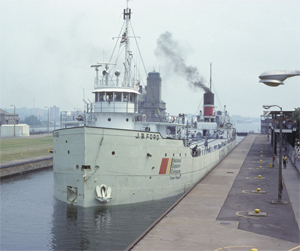The oldest active freighter on the Great Lakes awaits its fate at a Duluth, Minn., scrap yard, despite a years-long effort by a group of maritime preservationists to save the steamship.
Built by the American Shipbuilding Co., J.B. Ford was launched as Edwin F. Holmes on Dec. 12, 1903, in Lorain, Ohio. At 440 feet long, the vessel was powered by a 1,500-hp triple expansion steam engine.
Predating both world wars, it hauled iron ore, coal and grain for the first several decades of its life and famously survived two major storms — one in 1905 and another in 1913 — that wreaked havoc on the Great Lakes region and took several ships and lives with them.
It was cement that helped extend its life. Huron Portland Cement Co. purchased the well-suited ship in the 1950s. The company reconfigured its cargo hold and the ship was used for transport until being converted into a storage vessel — a role it served for more than 15 years. In 2001, J.B. Ford was taken to storage, a factor that largely attributed to its deterioration.
When the Great Lakes Steamship Society got wind in 2011 that J.B. Ford’s days were numbered, the nonprofit took up the historic vessel’s mantle. The group was able to negotiate a deal with the owner, LaFarge North America.
“They agreed to hold onto it as long as we were putting an effort forth,” said Steven Haverty, Great Lakes Steamship Society president and founder. The group had hoped to one day convert the ship into a floating museum.
While the society managed to raise $50,000, total renovation and preservation was estimated to cost $2 million to $3 million.
The ship could have been saved, but the money just wasn’t there, said Haverty, pointing to government grants drying up following the recession. The ship was riddled with asbestos and several areas were painted with lead paint or had developed leaks.
“If we can’t save the ship, we’ll try to save as many (artifacts) as we can,” Haverty said. “It’s the last of its kind from the turn of the century.”
He said the group would like to preserve the triple expansion steam engine, some smaller steam engines, the pilothouse, crew cabins, original wood paneling and other artifacts.
The Great Lakes Steamship Society plans to preserve what it can of J.B. Ford and save other historical ships. Its interests specifically lay with S.T. Crapo, an 88-year-old steamer and former flagship of Huron Portland Cement. The group also expects to develop a historical image database.
“It’s certainly disappointing that we weren’t able to save the Ford, but we’re still hopeful that by the time the Crapo becomes available, the situation will be better,” said Richard Jenkins, a member of the board of directors for the Great Lakes Steamship Society. “We did our best for the Ford, but now it’s time to let her go.”

